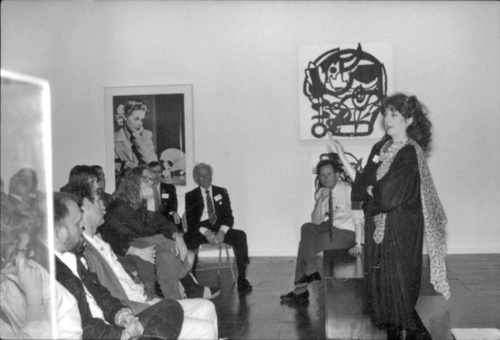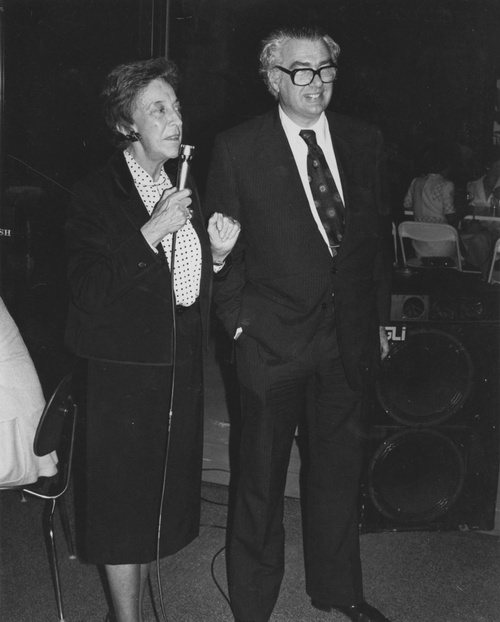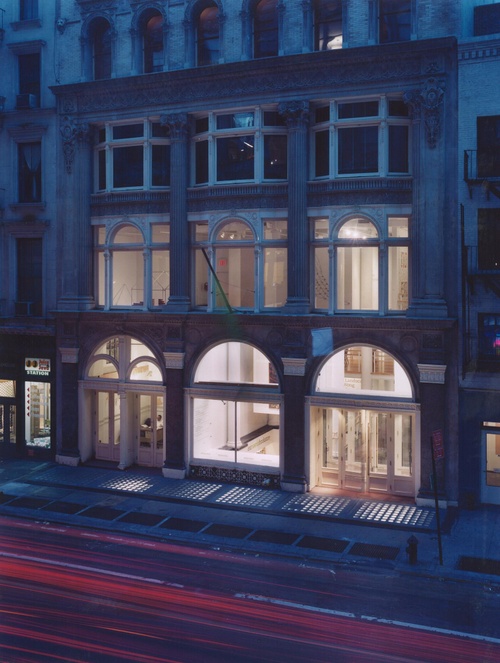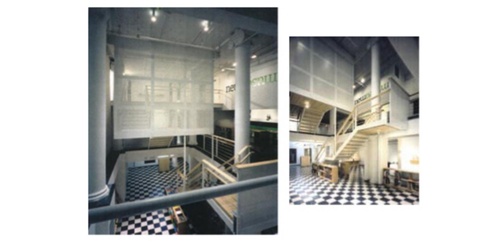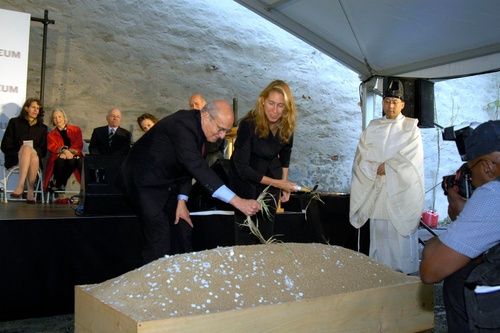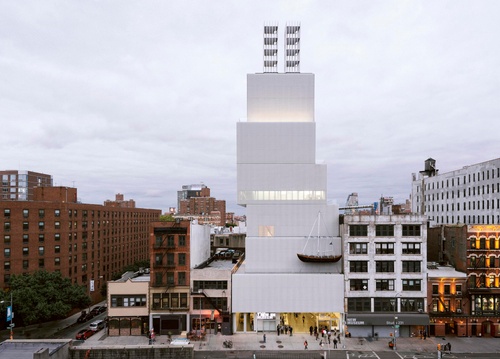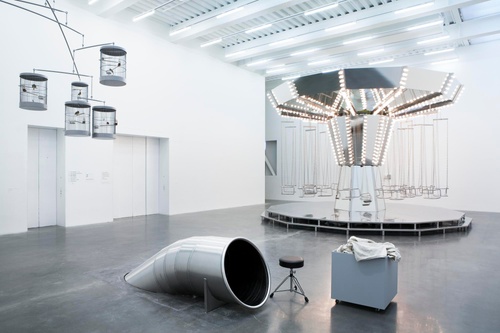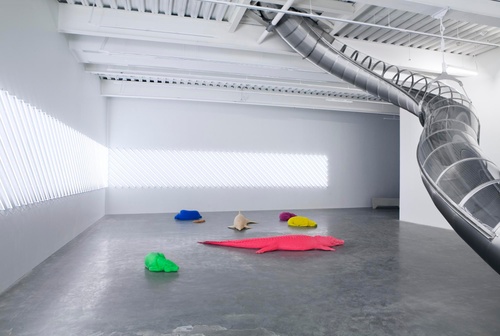Oral History: Saul Dennison
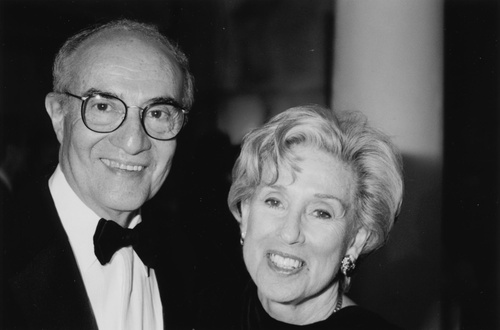
Saul and Ellyn Dennison attending the 1994 New Museum Benefit Auction and Gala. Photo: New Museum
NEW MUSEUM ORAL HISTORY INITIATIVE
SAUL DENNISON
TRUSTEE, 1990-99; PRESIDENT, 1999-2013; CHAIRMAN EMERITUS, 2013-PRESENT
INTERVIEWEE: Saul Dennison, Chairman Emeritus, New Museum
INTERVIEWER: Lisa Phillips, Toby Devan Lewis Director, New Museum
LOCATION: New Museum, New York, July 10, 2017
This interview has been condensed and lightly edited from the verbatim transcript. Readers are asked to bear in mind that they are reading a transcript of the spoken word, rather than written prose.
Full transcripts are available from the New Museum Archives by request.
Lisa Phillips: Well, tell me, do you remember when you first became involved with the New Museum?
Saul Dennison: I became involved through Richard Ekstract, who told me that I would enjoy doing it. We started touring the art galleries together and became friendly, and he was a Board member. I told him that I was interested in “giving back” to the art world because I was enjoying it so much, and it was a life-changing event for us.
So, joining the Board was a way to do that. Richard said, “Let me talk to Marcia [Tucker].” So, he came back later and said: “I asked Marcia if she knew you. She said, ‘Yes, I know him very well.’ He said, ‘How would you like him to be on the Board?’ She said, ‘I’d love it. When can we get him?’” [Laughs.] So, that was it.
Lisa Phillips: So, that’s when you joined the Board in 1990? And you weren’t a Member of the New Museum, or you weren’t involved with any of the groups up until that point?
Saul Dennison: Not really. I came to the shows, and I talked to Marcia about what I thought of them, and I asked her questions. I was more interested in learning than in telling her anything that I knew, because I was a neophyte in terms of the art. And she was very outgoing and giving to tell me anything I wanted to know. We went on trips, where she was with us, and that’s how we really got to know Marcia.
Lisa Phillips: And you were a Trustee at that time?
Saul Dennison: I’m not sure, when we did the first trip, whether I was a Trustee or just tagging along with Richard and Eileen Ekstract.
Lisa Phillips: And what was the Museum up to when you joined the Board? Do you remember what was going on in those days when you first joined?
Saul Dennison: I remember some of the shows from early on, but vaguely. “Bad Girls” [1994], I remember. And I remember the show they had with these three guys hanging on the wall that they brought from London [“The Living Paintings,” 1988], and you could go up and interact with the “art,” which I thought was kind of wacky and still do. [Laughs.]
But the Museum was willing to do that, to take risks. And I met the curators, and some of them were really interesting to me, and others were not… There were really good shows that Marcia put on as time went on.
Lisa Phillips: In the early ’90s, when New York City was having a real estate downturn and there was a recession going on, the Museum had some financial issues that you were very helpful, I think, in resolving.
Saul Dennison: One of the first issues that came up after I joined was with a challenge grant from Vera List [then Trustee Emeritus]. The Board had not met the goal. They said, maybe you can help us come up with an answer. So, I said, “Let me think about it.” And I thought about it, and I said, “Let’s ask Vera if she would accept paintings.” There were a lot of collectors on the Board, and we had a good selections of paintings that Trustees were willing to part with.
We asked Vera if we could use the value of those paintings to make up the difference, and she said yes. My wife and I immediately sent over half a dozen paintings, and other Trustees sent paintings from their collections. And it was very easy to reach the goal through the value of those paintings.
And she wrote a little check, you know, just out of her checkbook. I couldn’t get over it. She handwrote, for New Year’s Eve, five hundred thousand dollars on this little, tiny check as her contribution. And I said to myself, “I really have to get to know these people.” And I met her husband [Albert A. List], and he was a dream to talk to. I mean, he had me under his spell from the very moment we started.
Lisa Phillips: So, what I’m getting from what you’re saying is that there were so many opportunities at that time, way more than now. It was kind of a wide-open field for contemporary art.
Saul Dennison: At the Museum, absolutely. But the numbers were so different then.
Lisa Phillips: What were the biggest challenges for the Museum when you first joined the Board?
Saul Dennison: I think the challenge that I saw most had to do with the governance side of it. Everybody was kind of independent in what they did, but everybody loved the Museum. They would tell you how great the Museum was and how important it was, and they all believed it.
I remember they put me on a committee for the building, and I went to the committee meeting. It was at Nan Laitman’s house, and Hank [Henry “Hank” Luce III] was there, and three or four others. I had a pad and pencil, and I started taking some notes as we discussed all the various things, because I didn’t see anybody else doing that… By the end of the meeting, I had a notepad with enough information on it so that I could review it. And when I got home, I looked at it and said to myself, “You know, maybe the other people would like to see this, too.” So, I had my secretary type it up, and I sent a copy to everybody who was there.
That’s what made me President of the Museum’s Board. [Laughs.] Just doing that one thing.
Lisa Phillips: So, you became President of the Board in 1999.
Saul Dennison: That happened because Hank stepped down. I had met with him personally and asked him not to do that, because Marcia was also stepping down… But he never stopped contributing to the Museum. His foundation never stopped contributing to the Museum. And I loved Hank, I really did. I went to his events, to churches if somebody from the family died. He was a breath of fresh air is what he was.
The only other time that I got really involved with finances was after we fixed up the building. By then, you were involved, I think—when we sold the building.
Lisa Phillips: First, I think, you were involved in expanding the Museum at 583 Broadway [in 1995].
Saul Dennison: Yes.
Lisa Phillips: Weren’t you involved in negotiating for that additional floor?
Saul Dennison: I really did that all—
Lisa Phillips: You did that all yourself.
Saul Dennison: Yes. I did it myself because everybody wanted to do it together, as a group, but that was too difficult. You needed a smaller group. When I said I would meet with William Kriegel [the developer] on my own, Marcia and the other Trustees wanted—and properly so—for somebody else to join me. So, she called Allen Goldring and said, “Would you go to the meetings?” And Amy Chen went, who was the Director of Finance, but they realized quickly that when you’re dealing with a one-on-one situation, as we were in negotiating for the additional floor, you’ve got to let one person lead it, so I took the lead.
Lisa Phillips: Were you able to negotiate additional space for free? In exchange for some change in the bylaws or something?
Saul Dennison: Yes, that was the exact reason. Because we had all the cards. It’s like playing poker with somebody when you have four aces in your hand, and they’re trying to figure out what to do. But Kriegel was a very smart guy. He wanted to do this deal in the worst way, and he was very honest about it. He said, “I can’t do the deal because there’s nothing I can do in the building that doesn’t need your approval.”
Lisa Phillips: Because we had the majority of votes in the condo building?
Saul Dennison: Yes, and in the condo bylaws, approval by vote was necessary for anything that went on in the building.
Lisa Phillips: And he wanted that overturned.
Saul Dennison: He wanted that overturned so that he could do the renovations he wanted to do. And for that, he approached the Museum and was willing to give us a sizable sum of money. I said, “How much are you willing to give us?” He said, “Well, it might even be a million dollars.”
Lisa Phillips: So, he gave the extra space and the million dollars?
Saul Dennison: He didn’t give the million dollars. I said, “The million dollars is never going to fly.” [Laughs.]
This was a very interesting negotiation. It lasted a while, but the end result was that he gave us over two and a half million dollars, and he gave us the second floor.
Lisa Phillips: That was a great negotiation, and it positioned the Museum to be able to move into a new building, because we eventually sold our three-story condominium unit.
Saul Dennison: It was that deal that positioned us, eventually, with the fundraising that went on and everything that we did—and without going for bonds or anything else—to pay for the 235 Bowery building. And that’s not me. That was you more than me.
Lisa Phillips: It was all of us together.
Saul Dennison: Right, that’s true.
Lisa Phillips: And it was way more than we thought we’d be capable of when we first started out.
Saul Dennison: And we were sure that we were going to be able to build it for thirty-five million dollars. And we were a little off. But we paid for it—we paid it all off. [Laughs.]
Lisa Phillips: We did.
Lisa Phillips: So, what are you most proud of during this whole time that you’ve been involved with the Museum?
Saul Dennison: It’s hard. Everybody comes to my house and walks around looking at the pictures and they ask me, what’s my favorite picture? I don’t have a favorite picture. [Laughs.] I’m proud of what the group did as a group. I’m proud of the fact that we hired you, and I worked hard at making that happen. I’m proud of the fact that we were able to find some help from outside sources like Warren and Mitzi Eisenberg, and Leonard and Susan Feinstein.
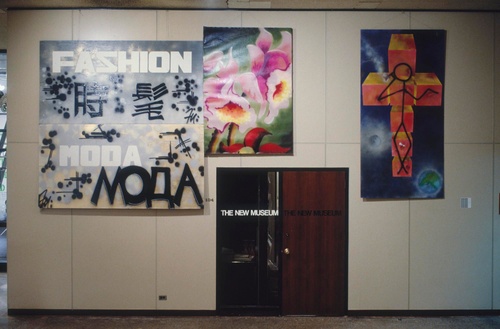
Events: “Fashion Moda” (1980) was part of a series of exhibitions in which artists’ groups were invited to organize shows at the New Museum. Located in the South Bronx, Fashion Moda was created with the intention of presenting art and ideas from cross-cultural sources in order to reach audiences with the widest possible spectrum of educational, economic, and cultural backgrounds. Exhibition view: New Museum. Photo: New Museum

When the New Museum first began collecting in 1978, its approach centered around a question posed by Marcia Tucker: “Could a collection of contemporary art remain contemporary?” At the time of the exhibition “Temporarily Possessed” (1995), the Museum described its collection as “a constantly changing body of work, an anti-collection of sorts that continually renews its status as a resource of contemporary work, rather than a monument to the past.” Exhibition view: New Museum. Photo: Fred Scruton
Lisa Phillips: Yes, and you really brought them into the New Museum. They were also very critical in making this happen.
Saul Dennison: Yes. They were, they were really—
Lisa Phillips: You were an essential part of building this museum.
Saul Dennison: There’s a note here from Warren thanking me for doing that. [Laughs.] I should be thanking him, and he’s thanking me.
But my wife, Ellyn, was the one who really found the Eisenbergs… And in terms of Warren, I had asked him for a contribution, and he agreed to supply the funds for one floor. And then he called me, and he said, “We just came back from a trip, and Leonard and I had a long discussion, and I’d like to meet you for breakfast.” And we went for breakfast, and he volunteered it. He said, “What will it cost to name the building?” I told him. He said, “Okay, we’ll do it.” I said, “I’ll pay for breakfast.” [Laughs.] He said, “No, you won’t. If I can pay for the building, you’re not paying for breakfast.” [Laughs.]
Lisa Phillips: It was a pretty thrilling time.
Saul Dennison: A very uplifting time for everyone who was involved, because they came to the meetings—nobody was reticent about talking about who could potentially be a funder. It was made possible by a very active Board.
Lisa Phillips: And everybody shared a passion for contemporary art.
Saul Dennison: Every single one. Every single one.
Lisa Phillips: When you first joined, did it feel like a museum? Did it feel like an alternative space? Did it feel like some hybrid thing? What was its relationship—in the cultural landscape of the city—to the other museums and other art spaces?
Saul Dennison: We were the White Columns to the Guggenheim. If you put everybody in a room one-on-one, and brought all the people who were running the other museums together, and put Marcia in the middle of it, we were as strong and as important as any one of them. But when you got to the building, and when you talked to the people who worked there, and looked at the lack of real organization, you knew it had to change. Or at least, I knew it had to change.
Lisa Phillips: So, it had the intellectual power and passion and the connection to artists, but it didn’t have the infrastructure, the management, or the governance infrastructure.
Saul Dennison: The passion, yes—the passion was there.
You know, the new artists—you would travel around, and you would meet some of the artists. That’s how you would meet them, on a trip. And they would say, “Oh, it’s my favorite museum.” Because these were the cutting-edge artists. They didn’t have a relationship with anybody at MoMA. But with us, we showed this kind of work. Emerging artists could get to be shown in the New Museum.
Lisa Phillips: It’s really fascinating, because when I came in ’99 from a collecting institution, I imagined, too, that we would become a collecting institution. That was another reason for this building, and there were many people in our orbit that had collections that would be looking for homes for them. But as we started exploring it—thinking it through, thinking about the resources required and the space required and the time—it became clear that this was not the right thing in order for the New Museum to stay contemporary, to stay responsive. It was going to weigh it down.
Saul Dennison: Yes.
Lisa Phillips: I do think that in the field we’re seen as being distinctive for not having a collection, for being able to experiment in other ways and do things that other institutions can’t and won’t do.
Saul Dennison: I know. I hear it all the time from people who are not involved in the art world. And they say, “You don’t have a collection?” And, “Are you giving all your art?” I said, “No, I’m not giving anything to them.” And they say, “Well, how do you get the art to show?” I say, “That’s not a problem for us. It’s about asking, What art do we want to show?” And most of the time, the artists want us to show their work—because they would rather be in the New Museum than any other place, in many cases.
Lisa Phillips: Isn’t that funny? Most people assume that when a museum has an exhibition, it’s from their collection.
Saul Dennison: Yes. And that we’re going to have a lot of difficulty finding somebody to lend us the art to show, which is not the case at all.
Lisa Phillips: Right. So, what do you think will be the challenges for the New Museum in the future?
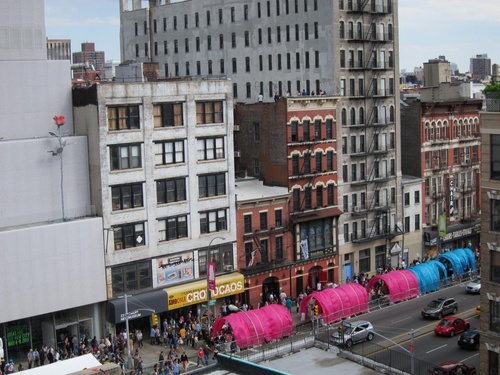
Inaugurated in 2011, IdeasCity invites civically engaged artists and architects from cities around the world to work with local experts to address urban issues and present their ideas to the community. Pictured are projects from past editions of IdeasCity in New York City. Nuit Blanche New York, Flash:Light, video projected on the New Museum façade, 2011. Photo: Benoit Pailley
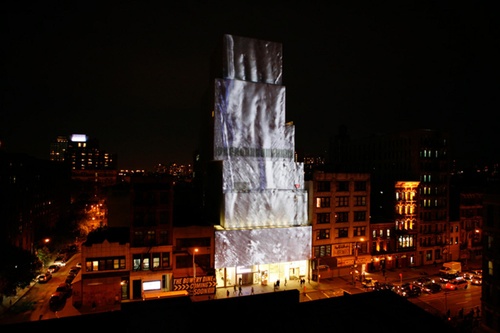
IdeasCity Street Festival on Bowery in front of the New Museum, 2011. Photo: Benoit Pailley
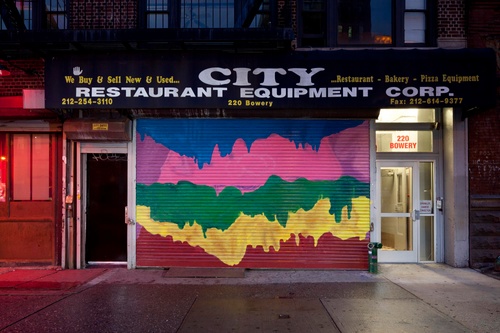
“Murals on the Bowery,” artwork by Deborah Kass, 2011. Photo: James Ewing
Saul Dennison: I think questions are apt to come up from time to time, and maybe that’s healthy, to be able to discuss it, and see whether we’re missing anything. I think the fact that we’re doing things that are outside of the scope of the typical museum is what’s made us different, by far, from any other museum in New York, and maybe in the United States. I mean, to be doing IdeasCity, to be doing NEW INC, to be affiliated with Rhizome—all of the other museums are doing some little thing like that, but not the way we are.
And we still have an outreach to our neighborhood, and we still have an outreach to the people who don’t collect art. And we still have an outreach to people who come to look at the Museum because it doesn’t show, necessarily, the art they expect to see, but rather has a slide where you can slide down through the museum, or that has some of the other differences that you would not see when you go to the other museums.
It’s not to denigrate the other institutions. I think they’re doing what they should be doing. But you need somebody like us, who is really outside the box. The bento box. [Laughs.]
Lisa Phillips: Well, I think that was a founding principle of the New Museum, wasn’t it?
Saul Dennison: Yes.
Lisa Phillips: To test out what a museum could be, what it could be in the future. Responding to the present and what different forms it might take. It seems that was part of Marcia’s founding intention.
Saul Dennison: I think it was. And it wasn’t difficult to get the Trustees to sign on to that, and to support it and come up with different ideas, and to support things that had nothing to do with hanging a picture on the wall.
Lisa Phillips: Is there anything else you’d like to add?
Saul Dennison: No. No, I’ve already resigned. [Laughs.]
Lisa Phillips: [Laughs.] I know. I have to just say that I feel like I’ve been so lucky to work with you all these years. It’s been a really special relationship, and it continues.
